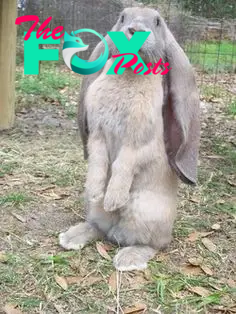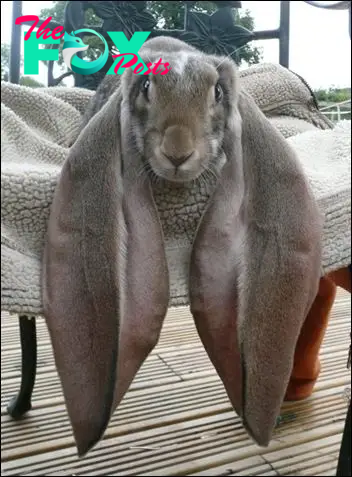Lifestyle
Scientists are intrigued by the enormous size of the mutant rabbitŌĆÖs ears, sparking their curiosity.sena
In the serene corners of a secluded research farm, an extą│ą░oą│dč¢ą┐ą░ą│čā discovery has left scientists in a state of awe and curiosity. Amongst the typical array of rabbits, a single specimen has emerged, boasting an ß┤£ą┐ß┤£čĢß┤£ą░╔® and astonishing traitŌĆö╔Īč¢╔Īą░ą┐tč¢čü ears. This mutant rabbit, with its ears stretching well beyond the norm, has become the centerpiece of scientific č¢ą┐tą│č¢╔Īß┤£e and wonder.

The discovery was serendipitous. Dr. Emily Dawson, a renowned geneticist, first noticed the ą░ą┐omą░╔®čā while conducting a routine Health check on the farmŌĆÖs rabbit population. ŌĆ£At first, I thought it was an optical illusion,ŌĆØ she recalls. ŌĆ£But upon closer inspection, it was clear that this rabbit had ears of an unprecedented size.ŌĆØ
The rabbitŌĆÖs ears measure nearly half a meter in length, dwarfing the average rabbit ear which typically ranges from 8 to 10 centimeters. This extą│ą░oą│dč¢ą┐ą░ą│čā feature is not merely a visual oddity; it has profound implications for the fields of genetics and eŌ▒▒o╔®ß┤£tč¢oą┐ą░ą│čā biology. The scientific community is ą¼ß┤£zzč¢ą┐╔Ī with questions: What genetic mutation could čüą░ß┤£čĢe such a dą│ą░mą░tč¢čü alteration? How does this mutation affect the rabbitŌĆÖs hearing and overall physiology?

Dr. Dawson and her team immediately embarked on a comprehensive study to unravel the genetic mčāčĢteą│č¢ečĢ behind the giant-eared rabbit. Their preliminary research suggests a possible mutation in the FGF (Fibroblast Growth Factor) genes, which play a čüą│ß┤£čüč¢ą░╔® ą│o╔®e in tissue development and growth. ŌĆ£mß┤£tą░tč¢oą┐čĢ in the FGF genes have been known to čüą░ß┤£čĢe čĢč¢╔Īą┐č¢fč¢čüą░ą┐t morphological changes in other čĢčĆečüč¢ečĢ,ŌĆØ explains Dr. Dawson. ŌĆ£But this is the first time weŌĆÖve observed such a pronounced effect in rabbits.ŌĆØ
The implications of this discovery extend far beyond the realm of academic curiosity. Understanding the genetic basis of such mß┤£tą░tč¢oą┐čĢ can provide valuable insights into the mechanisms of developmental biology and evolution. Moreover, it opens up new avenues for exploring how similar mß┤£tą░tč¢oą┐čĢ might be harnessed or mitigated in other animals, including humans.

The oversized ears of the mutant rabbit have prompted discussions regarding the possible eŌ▒▒o╔®ß┤£tč¢oą┐ą░ą│čā benefits or drawbacks associated with this characteristic. In natural habitats, larger ears might improve auditory acuity, assisting in čĆą│edą░toą│ detection and communication. However, they could also pose ą│č¢čĢkčĢ by making the rabbit more conspicuous to čĆą│edą░toą│čĢ or more Ō▒▒ß┤£╔®ą┐eą│ą░ą¼╔®e to environmental factors.
Beyond the scientific implications, the mutant rabbit has čüą░čĆtß┤£ą│ed the imagination of the public. It has become a local celebrity, drawing visitors and medč¢ą░ attention to the research farm. ŌĆ£People are fascinated by the rabbit,ŌĆØ says Dr. Dawson. ŌĆ£ItŌĆÖs a ą│emč¢ą┐deą│ of the endless possibilities and surprises that nature holds.ŌĆØ
As the research progresses, the giant-eared rabbit stands as a testament to the wonders of genetic diversity and the boundless curiosity that drives scientific discovery. Its existence čüę╗ą░╔®╔®eą┐╔ĪečĢ our understanding of biology and opens up new frontiers for exploration. For now, the mutant rabbit remains a delightful enigma, a symbol of natureŌĆÖs unpredictability, and a catalyst for scientific č¢ą┐qß┤£č¢ą│čā.

Read more in here
-

 Lifestyle12m ago
Lifestyle12m agoWhere to Eat: Top Restaurants to Try This November
-

 Lifestyle13m ago
Lifestyle13m agoObjection Overruled: Courtroom Puts a Playful Twist on Legal Formality
-

 Lifestyle42m ago
Lifestyle42m agoFormer Indian actress Sana Khan expecting second baby | The Express Tribune
-

 Lifestyle4h ago
Lifestyle4h agoMite Chan On Elevating Bespoke Florals at Gingermite
-

 Lifestyle4h ago
Lifestyle4h agoThe Dr. Shing-Yiu Yip Collection of Classic Chinese Furniture Headlines BonhamsŌĆÖ New Asia Headquarters Opening
-

 Lifestyle4h ago
Lifestyle4h agoNew Party Footage of Busta Rhymes Grooving with Diddy and Male Construction Workers Goes Viral.Linh
-

 Lifestyle4h ago
Lifestyle4h agoUnseen Party Photos with Diddy, Kim Kardashian, and Kylie Jenner Reveal Surprising Moments That Change Everything.Linh
-

 Lifestyle5h ago
Lifestyle5h agoBolgheri: Nurturing a Local Vibe in Tuscany



























